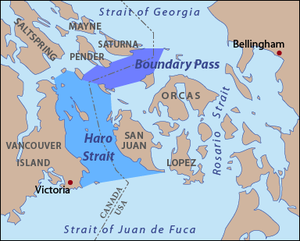Haro Street
| Haro Street | ||
|---|---|---|
| Haro Street | ||
| Connects waters | Juan de Fuca street | |
| with water | Strait of Georgia | |
| Separates land mass | Vancouver Island | |
| of land mass | San Juan Island | |
| Data | ||
| Geographical location | 48 ° 34 ′ N , 123 ° 14 ′ W | |
|
|
||
| length | 40 km | |
| Smallest width | 20 km | |
| Greatest depth | 18-275 | |
| Haro Strait between Vancouver Island and San Juan Island | ||
The Haro Strait ( English Haro Strait ) is an approximately 40 kilometers long and 20 kilometers wide waterway of the Pacific Ocean in the southwestern part of British Columbia , which separates Vancouver Island and the San Juan Islands . The course of the road here forms the border between Canada and the United States .
At the same time, the shipping lane is one of the busiest on the North American west coast as it is the main access route to the port of Vancouver and the Strait of Georgia .
definition
The USGS defines the course or the boundaries of Haro Street as described below. In the southwest, Discovery Island, in front of Victoria , forms one corner and the southern end of San Juan Island forms the other corner. To the north, the boundary of the Haro Strait is formed by a line beginning at the northern end of the Saanich Peninsula from Vancouver Island and then along the islands of Piers Island, Portland Island, Moresby Island, Stuart Island and Henry Island to the northern end of San Juan Island.
According to this definition, the Haro Strait does not merge directly into the Strait of Georgia at its northern end, but the two are first connected by the Boundary Pass .
Other definitions of the road include the Boundary Pass in the description of Haro Road.
history
According to the most widespread version, the street received its name in 1790 from the Spanish explorer and captain Manuel Quimper in honor of his navigator Gonzalo Lopez de Haro. A different version refers to the Archbishop of Mexico (1772 to 1800) Alonso Núñez de Haro y Peralta , who is said to have been the godfather for the name.
Before the street got its name from European explorers, it and the islands lying there were already hunting and settlement areas of various first nations , such as the Lummi , the Saanich or the Klallam .
In 1846, with the so-called Oregon Treaty, the border between the United States and Great Britain, along the 49th parallel, in the middle of the canal that separates the continent from Vancouver Island , and in the middle of the Juan de Fuca Strait to the Pacific Ocean set. Due to the many islands located there, there are two waterways that lead through the middle of the channel, on the one hand the Haro Strait west of the San Juan Islands and on the other hand the Rosario Strait along the east side of the archipelago. In 1859 a "war" broke out around the exact course of the border, the pig conflict . With the compromise reached in the end, Haro Street became the border.
A leper colony for Chinese immigrants was housed on the island of D'Arcy Island in Haro Strait from 1894 to 1924.
climate
The climate and water temperatures in Haro Strait are basically the same as those of the surrounding area of the Strait of Georgia, Juan de Fuca Strait and Rosario Strait. According to the Köppen climate classification , the climate is Mediterranean (Csb).
fauna
In addition to the killer whale and the Steller sea lions , there are also various types of salmon and other fish. Numerous sea birds can also be spotted, for example the guillemot .
See also
literature
- Sheila Harrington, Judi Stevenson (Eds.): Islands in the Salish Sea: A Community Atlas, Surrey 2005, 2nd ed. 2007
Web links
- Haro Street . In: BC Geographical Names (English)


